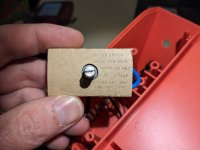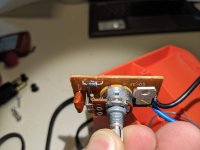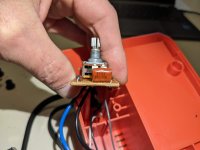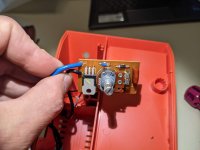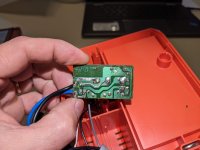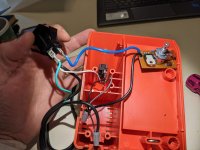Hi!
Is this comment in an Amazon review credible, and how would I replicate the test (the leads are not visible in the photo)?
Is this comment in an Amazon review credible, and how would I replicate the test (the leads are not visible in the photo)?
https://www.amazon.com/Weller-Digital-Soldering-Station-WLC100/dp/B000AS28UC/Un-grounded Tip Fried 30% of our Arduinos.
Reviewed in the United States on August 2, 2020

UNGROUNDED TIP WARNING! I rated this 5 stars so it wouldn't get lost in the reviews, but BUYER BEWARE if you are soldering ESD sensitive microelectronics. We had 2 of these in use on our PCB assembly line and after months of mysterious Microcontroller failures we finally traced the issue to this soldering iron. There is 30-volt AC running through the tip, see pic. This fried approx 30% of the Arduino Minis we backpack onto our PCBs. We thought we had a bad batch of mini's but finally found the issue. This soldering iron. Both of our identical units have this issue. Do not buy if you are using on anything remotely electrostatic sensitive.
Hi. Actually I've had similar problem while soldering 2n7002 with simple soldering iron , which was not grounded. Transistors become partially damaged, some had measurable resistance, leakages,partially turned on without control signal.
To measure leakage voltage , switch your digital multimeter to AC Volts mode , then connect black lead to your ac outlet ground , red lead touch to soldering iron metal part .You may need to use ac mains extender to have connection to outlet socket or another socket free while soldering station is plugged in.
You should see no voltage or very low voltage . Volt or so should do no damage ,but more than 20 volts will damage unpowerful mosfets , but most chip ic have protection diodes , so should survive i think.
To measure leakage voltage , switch your digital multimeter to AC Volts mode , then connect black lead to your ac outlet ground , red lead touch to soldering iron metal part .You may need to use ac mains extender to have connection to outlet socket or another socket free while soldering station is plugged in.
You should see no voltage or very low voltage . Volt or so should do no damage ,but more than 20 volts will damage unpowerful mosfets , but most chip ic have protection diodes , so should survive i think.
Is this comment in an Amazon review credible
It is credible.
For safety, the tip of the soldering iron must be grounded properly.
In addition, any static electricity that builds up on the tip will be discharged to ground instead of potentially damaging electronic components.
I read: "Although the AC is isolated from soldering tip, it is not a good practice to leave the iron tip floating. Upon handling and cord movement, the tip might accumulate electric charge."
At least grounding should be done through resistor in range 100k - 1Meg , can't remember now where exactly i've read that .
I've just purchased a Quick 1200D and was pondering these very questions. The instructions tell me:
Tip to ground resistance < 2mV
Tip to ground potential < 2R
Yes, the above are as printed...
See:
https://www.ipc.org/sites/default/files/test_methods_docs/2.5.33.3.pdf
https://www.hakko.com/english/support/maintenance/detail.php?seq=169
for some test methods
Tip to ground resistance < 2mV
Tip to ground potential < 2R
Yes, the above are as printed...
See:
https://www.ipc.org/sites/default/files/test_methods_docs/2.5.33.3.pdf
https://www.hakko.com/english/support/maintenance/detail.php?seq=169
for some test methods
Actually while measuring current as voltage drop at 1kiloohm is not complete check. Voltage drop will appear only if serious leakage appear , but mosfets can be easily killed by capacitive leak ,which will measure no voltage on 1k resistor. Mosfets g-s are rated +-20V mostly, some to 30V , but none at 110-120v , this you get easily with ungrounded tip at UK or EU , half of mains voltage . If need to be sure not to damage anything , measure plain voltage , do not use resistor as additional load.
Thanks! I used the 200VAC setting, the indication was 00.1, which I believe means high voltage isn't an issue with this particular unit(?)... To measure leakage voltage , switch your digital multimeter to AC Volts mode , then connect black lead to your ac outlet ground , red lead touch to soldering iron metal part .You may need to use ac mains extender to have connection to outlet socket or another socket free while soldering station is plugged in.
You should see no voltage or very low voltage . Volt or so should do no damage ,but more than 20 volts will damage unpowerful mosfets , but most chip ic have protection diodes , so should survive i think.
While the station uses a polarized grounded plugs, the iron (SPG40) uses a non-polarized ungrounded plug. I think this would eliminate the ability to ground the tip?... For safety, the tip of the soldering iron must be grounded properly.
In addition, any static electricity that builds up on the tip will be discharged to ground instead of potentially damaging electronic components.
I read: "Although the AC is isolated from soldering tip, it is not a good practice to leave the iron tip floating. Upon handling and cord movement, the tip might accumulate electric charge."
Interested question. Need to know whats inside soldering station, regular transformer, or smps , also how a tip is connected. If it uses T12 tips as example , they have three pins , one of them is like ground , one is heater itself and third is thermal sensor . If inside station is smps , i think input filters Y capacitors ground is already connected to tip ground, and you would have half mains voltage, if mains wire ungrounded. If it uses mains transformer 50/60hz ,and all electronics inside is powered after transformer , then maybe you can try connect soldering tip ground to mains ground through a resistor at best , that would prevent spark , if you discharge static electricity through tip and it's ground or handle . Insulation materials have high resistance to electrical current, but they still have capacity, and some discharge pulse may pass to device you solder . Through resistor is safer . Anyway , need to determine whats inside and how its connected .I think this would eliminate the ability to ground the tip?
IC's like Arduino normally have protection diodes on all pins (see datasheet), and should not be affected by moderate leakages or small ESD events.
Small MOSfets are entirely different: most, like 2N7000 do not have any protection, and their gate capacitance is small, meaning a tiny discharge can kill them.
Larger types do not have protection either, but their gate capacitance is in the nF range, which makes them relatively immune to "normal" events.
Having a "hard" earthing/grounding of the soldering iron can be counter-productive: you and what you solder may have some static charge, and a low-impedance path to ground can cause damages.
Grounding through a resistor (like 1Meg) dissipates the charge gently, and is safer (provided the iron is a class II device).
When I solder sensitive devices like 2N7000, I take some precautions: I touch the circuit and a conductive part of the soldering iron, or I wrap a thin naked wire around all the pins until the soldering is completed
Small MOSfets are entirely different: most, like 2N7000 do not have any protection, and their gate capacitance is small, meaning a tiny discharge can kill them.
Larger types do not have protection either, but their gate capacitance is in the nF range, which makes them relatively immune to "normal" events.
Having a "hard" earthing/grounding of the soldering iron can be counter-productive: you and what you solder may have some static charge, and a low-impedance path to ground can cause damages.
Grounding through a resistor (like 1Meg) dissipates the charge gently, and is safer (provided the iron is a class II device).
When I solder sensitive devices like 2N7000, I take some precautions: I touch the circuit and a conductive part of the soldering iron, or I wrap a thin naked wire around all the pins until the soldering is completed
Well, for anyone interested, the soldering station appears to be a simple lighted on-off switch and a "Zing Ear ZE-03 rotary lamp dimmer switch" which seems to be a commodity part.Interested question. Need to know whats inside soldering station, regular transformer, or smps , also how a tip is connected.
The mains ground connects to the mains ground terminal on the side outlet only.
The mains neutral is connected to the side outlet neutral terminal and the lighted on-off switch, I assume that's for the light?
The mains live is connected to the lighted on-off switch, then to the lamp dimmer, which is then connected to the side outlet live terminal.
I took pictures of the dimmer, but I didn't try to draw it out.
The tips simply sit inside the barrel, I didn't try to take the iron apart.
Attachments
So this is actually not exactly a soldering station, but just temperature regulator thing, which has no knowledge about real tip temperature. No thermal sensor . If mains wire ground is connected to outlet socket ground , then all should be fine , soldering iron is grounded , offcourse if your mains socket and power extension cable all are grounded . As i understand, you can connect any regular soldering iron to this regulator. I'm using simplified version of dimmer ,just 1n4007 diode , and additional socket for soldering tip connection, also in socket is small switch to short diode , when higher power is needed .
I have a XY-tronic soldering station that I got from Jameco at least 20 years ago. I measure about half an ohm (total lead resistance) from the end of the soldering tip to the third (ground) pin on the US line cord. I previously used a Weller soldering station with a similarly grounded tip that came to an abrupt end when I tried to solder something in an old guitar amp that had a hot chassis and a miswired power cord.
I have an AOUYE 888A hot air rework station that came from a Micro Center store in Cleveland for dealing with SMD stuff. It also has a pencil tip soldering iron on it. Both the hot air nozzle and the iron tip measure half an ohm to the ground pin on the power cord.
I also have a Stahl Tools soldering station from Parts Express that is labeled "ESD SAFE" right on the front panel, but has no continuity from the soldering tip to anything. Strangely enough one side of the heating element measures about half an ohm to the ground pin on the power cord.
I have an AOUYE 888A hot air rework station that came from a Micro Center store in Cleveland for dealing with SMD stuff. It also has a pencil tip soldering iron on it. Both the hot air nozzle and the iron tip measure half an ohm to the ground pin on the power cord.
I also have a Stahl Tools soldering station from Parts Express that is labeled "ESD SAFE" right on the front panel, but has no continuity from the soldering tip to anything. Strangely enough one side of the heating element measures about half an ohm to the ground pin on the power cord.
- Home
- Design & Build
- Equipment & Tools
- Check Soldering Iron grounding?
